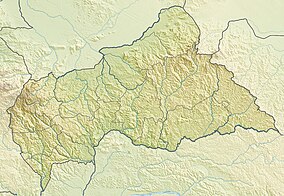
Back منتزه مانوفو غوندا سانت فلوريس Arabic Parque nacional del Manovo-Gounda St. Floris AST Manovo-Gounda St Floris vedeyaf gerd AVK Manovo-Qounda-Sen-Floris Milli Parkı Azerbaijani Taman Nasional Manovo-Gunda St. Floris BAN Национален парк Маново-Гоунда Сен Флорис Bulgarian Parc Nacional del Manovo-Gounda Saint-Floris Catalan Manovo-Gounda St. Floris National Park CEB Manovo-Gounda Saint Floris Czech Manovo-Gounda St. Floris Danish
| Manovo-Gounda St. Floris National Park | |
|---|---|
| Location | Central African Republic |
| Coordinates | 9°0′N 21°30′E / 9.000°N 21.500°E |
| Area | 17,400 km2 (6,700 sq mi) |
| Established | 1979 |
| Type | Natural |
| Criteria | ix, x |
| Designated | 1988 (12th session) |
| Reference no. | 475 |
| Region | Africa |
| Endangered | 1997–present |
Manovo-Gounda St. Floris National Park (French: Parc national du Manovo-Gounda St Floris) is a national park and UNESCO World Heritage Site located in the Central African Republic prefecture Bamingui-Bangoran, near the Chad border. It was inscribed to the list of World Heritage Sites in 1988 as a result of the diversity of life present within it.[1]
Notable species include black rhinoceroses, elephants, Sudan cheetahs, leopards, red-fronted gazelles, and buffalo, giraffes, lions; a wide range of waterfowl species also occurs in the northern floodplains.
The site is under threat due to its rare wildlife dying and animals species being wiped out. The western black rhinoceros that was indigenous to the Central African Republic has gone extinct in 2011. The site was added to the List of World Heritage in Danger after reports of illegal grazing and poaching by heavily armed hunters, who may have harvested as much as 80% of the park's wildlife. The shooting of four members of the park staff in early 1997 and a general state of deteriorating security brought all development projects and tourism to a halt.[2]
The government of the Central African Republic proposed to assign site management responsibility to a private foundation. The preparation of a detailed state of conservation report and rehabilitation plan for the site was recommended by the World Heritage Committee at its 1998 session. People are working on breeding programs to revive the natural wildlife.
- ^ "Manovo-Gounda St Floris National Park". UNESCO World Heritage Centre. Retrieved 2022-01-23.
- ^ "21 COM VIII.A.4 - Decision". UNESCO World Heritage Centre. Retrieved 2022-01-23.
